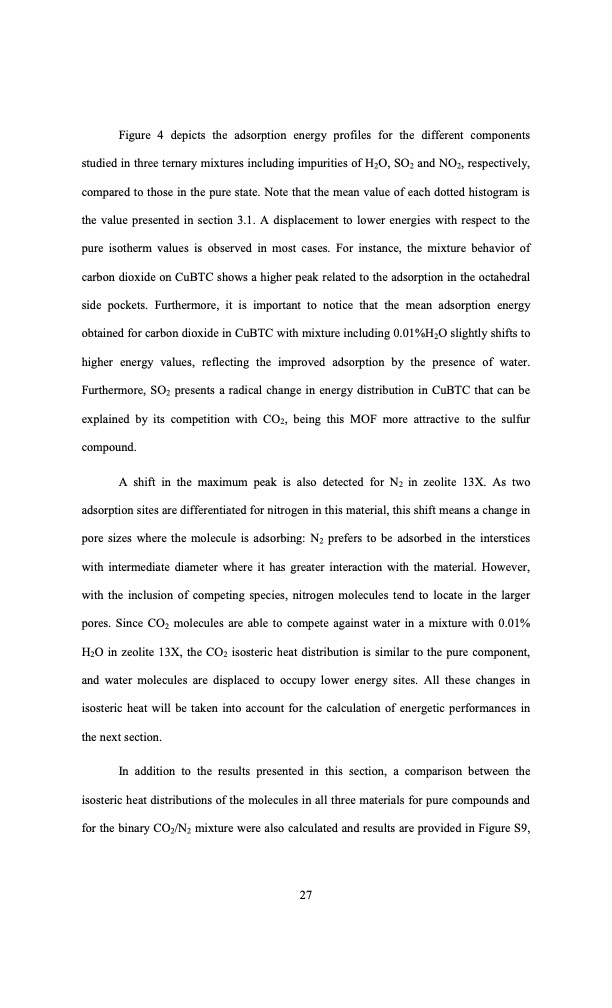
PDF Publication Title:
Text from PDF Page: 027
Figure 4 depicts the adsorption energy profiles for the different components studied in three ternary mixtures including impurities of H2O, SO2 and NO2, respectively, compared to those in the pure state. Note that the mean value of each dotted histogram is the value presented in section 3.1. A displacement to lower energies with respect to the pure isotherm values is observed in most cases. For instance, the mixture behavior of carbon dioxide on CuBTC shows a higher peak related to the adsorption in the octahedral side pockets. Furthermore, it is important to notice that the mean adsorption energy obtained for carbon dioxide in CuBTC with mixture including 0.01%H2O slightly shifts to higher energy values, reflecting the improved adsorption by the presence of water. Furthermore, SO2 presents a radical change in energy distribution in CuBTC that can be explained by its competition with CO2, being this MOF more attractive to the sulfur compound. A shift in the maximum peak is also detected for N2 in zeolite 13X. As two adsorption sites are differentiated for nitrogen in this material, this shift means a change in pore sizes where the molecule is adsorbing: N2 prefers to be adsorbed in the interstices with intermediate diameter where it has greater interaction with the material. However, with the inclusion of competing species, nitrogen molecules tend to locate in the larger pores. Since CO2 molecules are able to compete against water in a mixture with 0.01% H2O in zeolite 13X, the CO2 isosteric heat distribution is similar to the pure component, and water molecules are displaced to occupy lower energy sites. All these changes in isosteric heat will be taken into account for the calculation of energetic performances in the next section. In addition to the results presented in this section, a comparison between the isosteric heat distributions of the molecules in all three materials for pure compounds and for the binary CO2/N2 mixture were also calculated and results are provided in Figure S9, 27PDF Image | swing adsorption processes for CO2 capture in selected MOFs and zeolites

PDF Search Title:
swing adsorption processes for CO2 capture in selected MOFs and zeolitesOriginal File Name Searched:
679077.pdfDIY PDF Search: Google It | Yahoo | Bing
CO2 Organic Rankine Cycle Experimenter Platform The supercritical CO2 phase change system is both a heat pump and organic rankine cycle which can be used for those purposes and as a supercritical extractor for advanced subcritical and supercritical extraction technology. Uses include producing nanoparticles, precious metal CO2 extraction, lithium battery recycling, and other applications... More Info
Heat Pumps CO2 ORC Heat Pump System Platform More Info
| CONTACT TEL: 608-238-6001 Email: greg@infinityturbine.com | RSS | AMP |